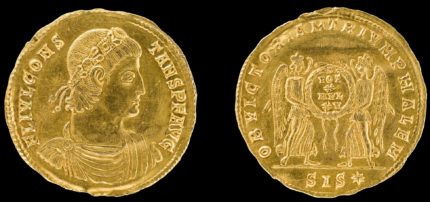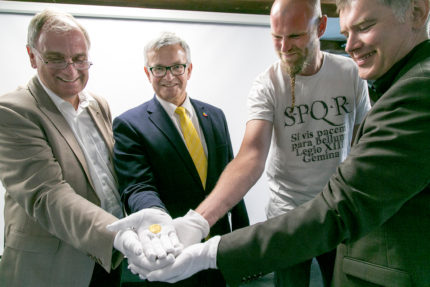A Roman gold coin that is unique in the archaeological record has been discovered by a metal detectorist in the Stade district of Lower Saxony, Germany. Matthias Glüsing was scanning a field near Fredenbeck in December of 2017 when he found the coin. The field is known for its prehistoric burial mounds, but it was significantly northeast of the boundaries of the Roman Empire. The coin was a most unexpected find.
It is a Multiplum of the Emperor Constans, youngest son of Constantine I, and was minted in 342/343 at Siscia in the Roman province of Pannonia Savia. The mint at Siscia, modern-day Sisak, Croatia, was opened by Gallienus in 262 A.D. and remained in use as imperial mint until the end of Gratian’s rule in 383 A.D. The coins struck there during the 4th century bear the mintmark SIS or SISC.
While their obverse and reverse images and inscriptions were derived from high-value circulation coins, multipla were not meant to spend. They were special issues created to commemorate the ascension of a new emperor, a great victory and jubilee years that would be given to a very select group of the emperor’s most loyal supporters in a special ceremony. Holes found in some of the survivors indicate they were worn as pendants by their honored recipients. Very few were made; even fewer survive. None of this type have been found before.
This one was modeled after a gold solidus Constans struck celebrating his victory over the Franks in 342. At nine grams, the Multiplum is twice the weight of the solidus. Its discovery so far north in such good condition may be an indication that it was gifted to a Saxon war leader who gave crucial aid to the Roman emperor. If so, it would be the earliest archaeological evidence of a Saxon military elite in what is now Lower Saxony. While there are references to a tribe north of the Elbe that can be interpreted as “Saxones” in Claudius Ptolemy’s 2nd century Geographia, the earliest undisputed account naming the Saxons comes from a speech delivered by future emperor Julian in 356 A.D. He names them as military allies of the Gallic usurper Magnentius who was acclaimed the new emperor by his troops after they killed Constans. The Multiplum predates that speech (and that alliance).
In recent months, the sensational discovery was intensively researched: At the site an excavation was carried out and searched with metal detectors. In addition, the archaeologists have evaluated historical maps and aerial photographs. “So far, there is good evidence to suggest that the gold coin was sacrificed in a special location characterized by a small moorland, a distinctive burial mound group, an ancient path and an impressive hill,” says [Stade district archaeologist Daniel] Nösler.
Lower Saxony requires that any metal detectorists who wish to search for archaeological materials or who search sites where archaeological materials are likely to be found apply for a permit. All would-be metal detectorists must take a free course to qualify for a permit, and they must contact the archaeologist overseeing the area they plan to explore ahead of time. This system ensures metal detector hobbyists have a proper grounding in how to approach archaeological finds and builds collaborative relationships between the amateurs and the professionals. Indeed, the finder participated in the follow-up archaeological excavation, scanning the wider site for potential areas of interest while archaeologists excavated the find site. Also, he is wearing an excellent t-shirt and I want it.
The coin has been acquired by the government and will go on display at the Stade Schwedenspeicher Museum. The museum has recently opened a new permanent exhibition on the pre-history of the Elbe-Weser-Triangle, and they are going to have to rewrite some of their information in the light of this discovery.


Ha! Ditto on the T-shirt!
“And lo, the great god Dtektrix looked down upon the sacrifice, and was pleased”.
Actually, the “interpretation” as Saxons/ Σάξονες is pretty forward, as in 150AD -probably in Egypt- Ptolemy had written (Book II, ch10):
———
…Κατέχουσι δὲ τῆς Γερμανίας τὰ μὲν παρὰ τὸν Ῥῆνον ποταμὸν …
Τὴν δὲ παρωκεανῖτιν κατέχουσιν ὑπὲρ μὲν τοὺς Βρουκτέρους οἱ Φρίσιοι μέχρι τοῦ Ἀμισίου ποταμοῦ, μετὰ δὲ τούτους Καῦχοι οἱ μικροὶ μέχρι τοῦ Οὐισούργιος ποταμοῦ· εἶτα Καῦχοι οἱ μείζους μέχρι τοῦ Ἄλβιος ποταμοῦ· ἐφεξῆς δὲ ἐπὶ τὸν αὐχένα τῆς Κιμβρικῆς Ξερσονήσου Σάξονες, αὐτὴν δὲ τὴν χερσόνησον ὑπὲρ μὲν τοὺς Σάξονας Σιγούλωνες ἀπὸ δυσμῶν, εἶτα Σαβαλίγγιοι, εἶτα Κοβανδοὶ, ὑπὲρ οὓς Χάλοι, καὶ ἔτι ὑπὲρ τούτους δυσμικώτεροι μὲν Φουνδούσιοι, ἀναταολικώτεροι δὲ Χαροῦδες, πάντων δ’ ἀρκτικώτεροι Κίμβροι· μετὰ δὲ τοὺς Σάξονας ἀπὸ τοῦ Χαλούσου ποταμοῦ μέχρι τοῦ Συήβου ποταμοῦ Φαροδεινοὶ, εἶτα Σειδινοὶ μέχρι τοῦ Οὐιαδούα ποταμοῦ, καὶ μετ’ αὐτοὺς Ῥουτίκλειοι μέχρι τοῦ Οὐιστούλα ποταμοῦ. …
“…In Germany live on the other side of the Rhine river […] Further, the [German] Okeanos shore is inhabited above the Brukteroi up to the Amisian river by the Frisoi, then by the Kauchoi up to the river Weser as a minority, and after that by the Kauchoi up to the river Elbe in majority. From there, up to the throat in the Kimbrian peninsula by the Saxons, the said peninsula starting by the narrow point above the Saxons by the Sigoulones, then by the Sabalingioi, after that follow the Kobandoi, above those the Chaloi [Skalvians?], and still above them (‘dysmikoteroi’? on the other side of the narrow point?) the Fundusioi, further east the Charoudes and far up North the Kimbroi. After the Saxons from the Chalusian river to the Suebian river live the Pharodeinoi, after that the Seidinoi up to the Oder river, and after those the Routikleioi up to the Vistula river. … “
———
Ptolemy even mentions a spot south of the Elbe river near to Fredenbeck ( 53° 32′ N, 9° 24′ E – where that coin from two centuries later was found):
Φαβίρανον –or Fabiranum– which had been identified with Sievern (53° 38′ 44″ N, 8° 36′ 16″ E).
Trier, however, had been one of the residences of the Western Roman Emperors in Late Antiquity, until they moved to Arles and Trier was lost to the Franks after 450AD for good.
:hattip:
:yes: Great article. It seems the Romans had traveled to many parts of Germany.
Unfortunately, the coin does not point out, which “triumphant victory” it refers to exactly:
“Ob Victoriam Triumphalem – Fl(avius) Jul(ius) Constans P(ius) F(elix) Aug(ustus)”.
However, Anglia (Angeln/ Angel) is a small peninsula within the Kimbrian peninsula in the region of Southern Schleswig, or according to Ptolemy in 150AD:
——
..Τῶν δὲ ἐντὸς καὶ μεσογείων ἐθνῶν μέγιστα μέν ἐστι τό τε τῶν Συήβων τῶν Ἀγγειλῶν, οἵ εἰσιν ἀνατολικώτεροι τῶν Λαγγοβάρδων ἀνατείνοντες πρὸς τὰς ἂρκτους μέχρι τῶν μέσων τοῦ Ἄλβιος ποταμοῦ, καὶ τὸ τῶν Συήβων τῶν Σεμνόνων, οἵτινες διήκουσι μετὰ τὸν Ἅλβιν ἀπὸ τοῦ εἰρημένου μέρους πρὸς ἀνατολὰς μέχρι τοῦ Συήβου ποταμοῦ, καὶ τὸ τῶν Βουργουντῶν τὰ ἐφεξῆς καὶ μέχρι τοῦ Οὐιστούλα κατεχόντων. ..
“..Among the interior people and those wo live inland, the most important ones are the Sueboi Angles, who are to the east of the Langobardoi, towards the north and up to the central part of the Elbe river, and the Suebian Semnones, whose boundaries beyond the Elbe from the area we mentioned towards the east up to the Suebian river, and the Burgundai live one after another from there to the Vistula..”
——
FYI – The author discusses Albion island of Britannia in chapter2. However, according to him, the following towns are found in Germany in the northern climate [“zone 1”, coordinates omitted], Πόλεις δὲ τίθενται κατὰ τὴν Γερμανίαν ἐν μὲν τῷ ἀρκτικῷ κλίματι αἵδε· :
—
Φληούμ (Phleum, Velsen?), Σιατουτάνδα (Siatutanda, Sustrum?), Φαβίρανον (Fabiranum, Sievern), Τρήουα (Treva, Hamburg, Tadeslo, Bad Oldesloe?), Λευφάνα (Leufana, Hitzacker), Λιριμιρίς (Lirimiris, Hagenow), Μαριωνίς (Marionis, Schönberg, 15km east of Lübeck at the river Maurine), Μαριωνίς ἑτέρα (yet another Marionis, Lalendorf), Κοινόηνον (Coenoënum, Waren, Müritz), Κιστουία (Kistuia, Stargard Castle), Αλείός (Alisus, Temmen), Λακιβρούργιον (Laciburgium, Ueckermünde), Βουνίτιον (Bunitium, Lubieszewo/ Lübsow), Οὐιρουνον (Virunum, Drawsko Pomorskie/ Dramburg), Οὐρίτιον (Viritium, Czlopa/ Schloppe), Ῥούγιον (Rugium, Rügenwalde/ Darłowo? Miastko/Rummelsburg?), Σκοῦργον (Scurgum, Chojnice? Skórcz/Skurz? Czersk?) and ᾿Ασκαυκαλίς (Ascaucalis, Osielsko).
—
Ἐν δὲ τῷ ὑπὸ τουτο κλίματι πόλεις αἵδε· – “zone 3” [below “zone 2”, which I gracefully here omit]:
Αλεισόν (Alisum, Bergisch Gladbach?), Βουδόρις (Budoris, Drachenfels, Central Palatinate Forest), Ματτιακόν (Mattiacum, Lahnau-Waldgirmes), Αρκταυνον (Arctaunum, Heidetrank Oppidum?), Νουαίσιον (Novaesium, Melsungen), Μηλόκαβος (Melocabus, ?), Γραυιονάριον (Gravionarium, Schlüchtern), Λοκόριτον (Locoritum, Lohr am Main), Σεγόδουνον (Segodunum, Bad Wimpfen), Δηούονα (Devona), Βέργιον (Bergium, Würzburg), Μηνόσγαδα (Menosgada, Staffelberg), Βικούργιον (Bicurgium, Gleichberg), Μαρόβουδον (Marobudum, Amberg), Ῥεδιντούινον (Redintuinum, Louny/Laun), Νομιστήριον (Nomisterium), Μελιόδουνον (Meliodunum), Κασουργίς (Casurgis), Στρεουίντα (Strevinta), Ἡγητματία (Hegetmatia), Βουδοργίς (Budorgis), Ἔβουρον (Eburum), Αρσικουα (Arsicua), Παρίεννα (Parienna), Σετουία (Setovia), Καρρόδουνον (Carrodunum, Rýmařov), Ασάνκα (Asanca)
—
“Climatic zone 4″, Ἐν δὲ τῷ λοιπῷ καὶ παρὰ τὸν Δανούβιον ποταμὸν πόλεις αἵδε· Remaining, near the Danube the towns are:
Ταρόδουνον (Tarodunum, Kirchzarten), Βωμοὶ Φλαύιοι (Arae Flaviae, Flavian Altars, Rottweil), Ῥιοσιαούα (Riusiava, Oppidum Heidengraben), Άλκιμοεννίς (Alcimoënnis, Sontheim an der Brenz), Καντιοιβίς (Kantioibis, Aalen), Βίβακον (Bibacum, Weißenburg), Βρονδεντία (Brodentia, Donauwörth), Σετουάκωτον (Setuacotum, Treuchtlingen), Οὔσβιον (Usbium, Linz?), Άβίλουνον (Abilunion, Freistadt ), Φουργισατίς (Furgisatis, Budweis), Μεδιολάνιον (Mediolanium, Korneuburg), Φηλικία (Felicia, Vyškov/ Wischau), Ἐβουρόδουνον (Eburodunum, Oberleiserberg), Ανδουαίτιον (Anduaetium, Andovce), Κελαμαντία (Celamantia, Brigetio), Σινγονή (Singone, Šarovce), Αναυό (Anavum/Adiabum, Komárno/ Komorn?).
:hattip: